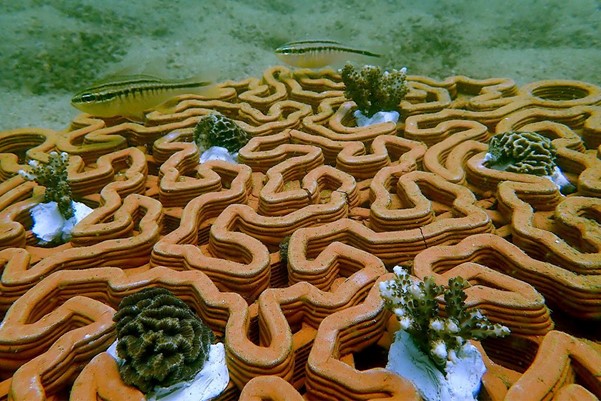
Reef Revolution: How Implementation of 3D Printing Can Promote Sustainable Coral Restoration
Coral reef damage can have catastrophic effects beyond marine life
Coral reefs play a crucial role in the well-being of marine ecosystems by providing habitat for various ocean organisms. In the span of a decade, it is estimated that coral reefs can benefit 5.3 million people and protect $109 billion worth of gross domestic product (GDP) worldwide. This highlights their importance, especially for maritime countries.
3D printing, a breakthrough solution for coral reef restoration
Three-dimensional printing, commonly known as 3D printing, is a manufacturing process that creates a physical object from a digital design by layering materials, usually plastic or polymer. This technology is considered revolutionary. Although currently too slow for mass production, its successful integration into such processes in the future could significantly enhance manufacturing productivity and potentially transform traditional manufacturing methods. 3D printing offers several benefits, including rapid prototyping, which allows for the quick and cost-effective creation of prototypes. It also enables easy customization and personalization, allows for the creation of complex designs that foster innovation and design freedom, and reduces material waste by using only the necessary amount of materials.
The 3D printing technology can be characterised as quite flexible by being able to accommodate different materials and the creation of various designs and complexities. Furthermore, it can be implemented through different methods, the three most common being binder jetting, paste-based extrusion, and fused deposition modelling (FDM). Each method has its strengths and weaknesses. The precision with which the binder jetting method can create objects with complex and intricate shapes is well known. FDM, popular and reasonably priced, works particularly well with thermoplastic polymers and bioplastics. The paste-based extrusion method, although not as precise as FDM or binder jetting, is quick and affordable for creating intricate structures in a variety of sizes.
The growth of 3D printing technology offers a promising alternative to restoring damaged coral reefs. This promotes the United Nation’s Sustainable Development Goal (SDG) No.14 which calls for “Conservation and Sustainable Use of the Oceans, Seas, and Marine Resources.” In particular, it emphasises how urgent it is to take preventative action to protect ocean ecosystems.
One of its targets entails maintaining and managing marine ecosystems sustainably by using restorative strategies and enhancing their resilience. It also intends to improve research capacities and apply marine technologies to improve biodiversity and ocean health, especially in developing countries. Considering the powerful impact coral reefs have on ocean ecosystems, focusing on its restoration could bring a massive leap forward in achieving SDG No.14’s targets. With this, coral reef restoration can be accomplished by creating 3D-printed artificial reefs to replace previously destroyed reefs. The advantages of 3D-printed corals include expanding the available habitat for various marine animals, increasing the structural complexity of reefs, facilitating the settlement of organisms essential for reef formation, and reducing the negative impacts of diving activities on natural reefs.
Exploring the potential of 3D-printed reefs
The success of 3D-printed coral reefs in Hong Kong
The implementation of 3D printing to create artificial reefs has been successfully done by Archireef in Hong Kong. Archireef generates revenue through a subscription where clients pay to have a reef area restored in their name. The positive results attained by the company’s various projects reflect the possible business opportunities in developing 3D printing technology, hence also benefiting the prospects of their partners and suppliers.
Archireef uses 3D-printed terracotta clay, which is a non-toxic and biodegradable material, to create terracotta coral tiles. Throughout the project’s lifetime, they have achieved a 95% coral survival rate. This shows promise regarding the potential of developing the solution for other countries. Aside from terracotta clay, which has been proven to be successful, 3D printing products can also be sourced from calcium carbonate, a sustainable and renewable material that can be found abundantly in multiple natural resources.
Collaborations between educational institutions have been crucial in the development and deployment of 3D-printed coral reefs in Hong Kong. These institutions have research teams and projects specifically focused on marine restoration and developing 3D printing for coral tiles. Additionally, the government supports these restoration projects by providing funding. Hong Kong’s Agriculture, Fisheries and Conservation Department has commissioned a project specifically for coral restoration within Hong Kong’s ocean areas. The 3D-printed coral reefs implemented in Hong Kong were carefully designed to withstand the local water conditions, facilitating coral restoration while considering the impact on local biodiversity. The success of these projects can be attributed to the strong collaboration between research institutions and the government, which plays a significant role in the development and implementation of this emerging technology.
Navigating the complexities of 3D-printed artificial reefs
Along with the benefits that come with 3D printing artificial reefs, it is important to take the possible risks, ethical implications, and considerations of the solution before fully committing to it.
Complexity and compatibility of design
3D-printed artificial reefs is not a one-size-fits-all solution. It needs to be designed to reflect the complexity and structure of coral habitats, including topographic characteristics, that they are intending to target. The compatibility of artificial reef design and environment will affect the organisms it attracts and supports. The inability to achieve this might risk attracting species that are not native to the reefs, which therefore messes with ecosystem conditions. The emergence of artificial coral in natural habitats may also increase the possibility of diverting living organisms from natural coral reefs which in the long run could affect their prosperity.
Material selection and maintenance
The materials chosen to create the 3D-printed corals also play a part, as it can affect the durability of the artificial coral structure, which needs to exhibit strength and resilience to be able to withstand harsh ocean conditions. Failing to do so could cause the artificial reefs to break apart and pose hazards to the marine ecosystem. In addition, the biocompatibility of the materials with the environment needs to be considered to eliminate the possibility of harm to the marine ecosystem. Ensuring this and anticipating other possible outcomes would require long-term maintenance and monitoring, which would require the allocation of resources, expertise, and dedication from the stakeholders involved.
The successful implementation of 3D-printed reefs in Hong Kong is partly due to the careful selection of materials designed to withstand the conditions of the region’s subtropical waters. Factors such as temperature and salinity were considered, leading to the decision to use clay, which remains durable under these specific underwater conditions.
Ethical dilemmas
Another aspect to consider is the possible ethical dilemmas that come with it. Implementation of technology to tackle ecological challenges may promote the mindset that, no matter what the issue is, there are going to be technological fixes to tackle it. This would create a dependency on technology and shift the focus from making systemic changes and adopting sustainable practices that will address the issue from its root.
Fostering responsible innovation and governance in coral reef restoration
The long-term effectiveness of coral reef restoration requires public awareness, education, and support for the initiatives. Without this, the general public might not understand the extent of coral reef importance, and therefore, the initiatives might not have as effective an impact as intended. The adequacy of regulations to mitigate risks and ensure public interests could raise concerns about whether these regulations have been developed to their full extent and will be responsibly executed.
To tackle the potential risks and dilemmas, Responsible research and innovation (RRI) can be used to effectively steer the development of responsible governance strategies. The four key elements of RRI namely anticipate, reflect, engage, and act, address different phases of technology implementation. In the context of 3D printing for coral restoration, it’s crucial to anticipate the potential impacts of materials and production processes, considering their potential unknown impacts. Reflecting on the motivations of companies behind such solutions and evaluating their goals over time is essential for ensuring alignment with their vision and addressing emerging implications post-implementation. Engaging in discussions about the long-term suitability of the solution can influence the trajectory of 3D printing development for coral restoration, encompassing both engagement and action aspects of RRI.
Can 3D printing revolutionise coral restoration?
Governance and RRI
The living form of coral reefs is the real value-creator for marine ecosystems; therefore, approaching the problem by utilising 3D-printed artificial reefs can only act as a temporary solution. It is crucial to be aware that instead of focusing on the implementation of technology in the restoration of damaged coral reefs, what needs to be done is to tackle the root of the issue by adopting more sustainable practices to conserve and protect existing healthy reefs. Implementing the aspects of RRI is crucial to ensure that the solution, in this case 3D printing, is implemented responsibly and represent an effective alternative to address the issue of coral degradation.
Business practices
The success of Archireef demonstrates the potential of 3D printing for coral restoration as a promising business opportunity, particularly for entrepreneurs who are interested in pursuing ventures dedicated to sustainability. This innovative solution can attract customers and investors who prioritise the well-being of ocean ecosystems.
Individual awareness and behaviour change
As individuals, this can be done by reducing pollution, using reef-safe sunscreen, practising sustainable fishing, minimising carbon footprints, supporting marine protected areas, engaging in responsible tourism, participating in reef restoration, and raising awareness regarding the role of coral reefs and its conservation needs. The government’s role would be to support initiatives towards coral restoration and implement governance strategies that regulate activities that might have an impact on coral reefs.
The promise of 3D printing
Introducing 3D printing technology for coral restoration shows great promise and could be revolutionary. It represents a positive leap toward a flourishing marine ecosystem, particularly for maritime countries. The success of implementing 3D printing in coral restoration depends on well-considered design and governance, which are crucial supporting aspects.
About the author
 Nisrina Iswara is an MSc Innovation Management and Entrepreneurship student at the University of Manchester with a background in industrial engineering. She has a passion for the implementation of sustainable technologies and the transition of enterprises towards a circular economy, as she hopes that the future can be kinder to the environment while embracing innovation growth.
Nisrina Iswara is an MSc Innovation Management and Entrepreneurship student at the University of Manchester with a background in industrial engineering. She has a passion for the implementation of sustainable technologies and the transition of enterprises towards a circular economy, as she hopes that the future can be kinder to the environment while embracing innovation growth.

0 Comments